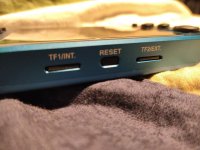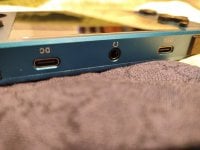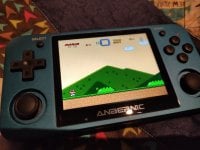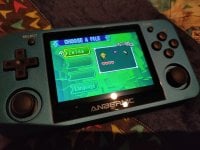 Anbernic RG351MP (Hardware)
Anbernic RG351MP (Hardware)
Official GBAtemp Review
Product Information:
At this point, Anbernic is well know. Since their early days they've gained a reputation for delivering on quality handheld after quality handheld, setting an incredible standard for the market of emulation systems. With the RG351 already having been released as the P, M, and V model, let's first have a brief look at this series of handhelds and how the MP differs to those before it.
As a site, we've actually covered each of the previous 351 models. The P, the original handheld in the series, was the first Anbernic system to sport the RK3326. Enabling solid PS1 emulation, as well as light N64 and PSP action, it was the chip to have when it launched back in 2020. The P model featured a 480x320 display, coming in at a 3:2 aspect ratio, and housed in a plastic shell. Though early models featured a WiFi chip, it was later removed due to issues with speaker noise. All things considered it was a great device and a perfect fit for GBA emulation thanks to its display.
Next on the block was the M model. Rocking largely the same internals as the P before it, the M came encased in a metal shell along with a now-fixed internal WiFi module. You have the same RK3326 and the same 480x320 display, the same layout, and the same controls. Though the metal shell is the major selling point here, giving an already-premium handheld a stellar finish, the fixed WiFi module is something that shouldn't be overlooked. Due to the device having a single Micro SD slot, transferring games can be a pain with Windows not recognising cards formatted for Linux operating systems. Add to this the ability to use RetroAchievements, and you have a relatively solid upgrade to the base hardware.
Featuring again the RK3326 this time in a form factor closer to the original GameBoy, the V model is probably the most interesting deviation in the series. Maintaining the WiFi module of the M model, the V features a more universally retro-suited 4:3 display, as well as a dual Micro SD setup. Outside of the obvious form factor changes, the biggest leap here is allowing you to use two Micro SD cards in the system. Completely skirting the pain of Linux partitions, you're able to keep one card formatted as an easier to manage Fat32 drive. It's also worth mentioning that due to limitations in the design, you're stuck with one analogue stick. This could get in the way of fully appreciating the improved PS1 and N64 performance that would really shine on the 640x480 display.
If you're interested in reading more about the previous models, you can check out our more in-depth coverage below:
With the history lesson over, we can now come to appreciate exactly what the MP brings to the table. Interestingly, you end up with a strange hybrid console, bringing together the pros and cons of its predecessors. At a surface level, you have the same basic layout as the M and P models. Where this differs from these is mostly in its display, packing the same 640x480 screen we enjoyed on the V model. Also coming from the V model is the dual Micro SD support, which is something I really can't praise enough having fought with Windows and Linux-formatted partitions in the past.
The build quality lives up to everything I've heard about Anbernic. It's phenomenal, and the metalic ocean blue colour that debuted with the MP model is something that looks a lot better in person than in any of their promotional images. Each button has a reasonable amount of resistance and no part of it feels mushy or cheap. As is common with emulation handhelds, you have two analogue sticks of the same variety as the Nintendo Switch's Joy Cons. While this does mean they may be prone to some of the same issues down the line, it is worth saying you're unlikely to be relying on them as much with retro titles. In use they do however feel great, and it's nice to use the left analogue as a D-Pad alternative from time to time.
Setup on the MP is almost as simple as plug and play. If you're happy with the included EmuELEC operating system and are happy to rely on their generic cards, you can stick some games on the second card and get on with what you bought it for. Not a fan of EmuELEC myself and somewhat untrusting of generic cards, I opted to grab a 16GB and 64GB Sandisk card for the OS and games respectively. Instead of EmuELEC, I downloaded the appropriate distribution of Lakka, wrote it to the smaller card, and was good to go. As operating systems go, Lakka is about as pure a RetroArch experience as you can get. I was first introduced to it with the various efforts to port it to the Switch and it's not let me down since. The UI looks fantastic on the display, and adding games is as simple as scanning the card. It is worth noting that some ROM hacks and translations won't be picked up though, so you may need to get comfortable with editing the playlist JSON files to add in games for yourself. It's not a complicated process, and you'll only need to mess with it when adding non-standard games.
Probably the standout of the unit, the 640x480 display is absolutely gorgeous. Thanks to that 4:3 aspect ratio, you're getting an optimal experience with the good majority of home retro consoles. Having mostly used the unit for SNES titles, I can't fault it. It is worth adding that black bars haven't ruined anything for me, if you were cautious of trying GameBoy or GBA games. Both of these systems still look great, but if GBA is your focus, the M model may be a better fit thanks to its 3:2 screen. Looking past the screen, there's only really one standout difference left between the M and MP models, and it's unfortunately not a good one. The internal WiFi module has once again been removed.
The MP ticks every other box brilliantly, which is why the lack of built-in WiFi is such a shame. To give credit to Anbernic, the system does ship with a USB C adapter and a USB A WiFi dongle but it's clunky at best, and far from ideal for people wanting access to RetroAchievements for every play session. I don't think this would be quite as much of a problem if there were a USB C WiFi dongle that sits a little closer to the system. Thanks to the MP having a separate OTG and DC USB C port, you at least aren't limited to WiFi when the system isn't charging. For me at least, achievements aren't something I look for, and the dongle did fine for the initial setup and FTP test. Regardless it just doesn't seem an ideal solution for the wider market.
As a slight aside here, it is possible to get a replacement for the bundled dongle and adapter should you end up relying on them and lose them, as well as the included screen protector via Anbernic's official Aliexpress store. Having messed up my initial screen protector installation I decided to give it a shot, and for around £10 I had it in the UK within a week. I can't really fault the service, which gives me confidence in their store should replacement parts become available in future, or if I just decide to try something else from their range.
I'm not going to go into too much detail as to what this handheld can and can't run to avoid covering the same stuff again. From a capability standpoint, it's exactly on par with its predecessors in the 351 series, and many other handhelds out there running the same chip. I've had absolutely no issues running NES, SNES, GB(C), and GBA titles. On top of this, a few N64 titles like Mario 64 run great, but going beyond that you're likely to encounter issues.
If like me you're only really wanting a handheld to push as far as the SNES and GBA, the RK3326 chip still holds strong. If these really are all you're after, along with a nice screen and a fantastic build quality, the 351MP is a solid choice. With emulation handhelds, there's always something on the horizon however, and you should always be aware of the fact something better is likely right around the corner. This is true now more than ever with the RK3326 at the end of its era, hopefully soon to step aside to a new generation. Whether you choose to wait or jump in now, I can't recommend Anbernic's handheld enough.
Verdict
- Fantastic 4:3 display
- Standard Anbernic build quality
- Dual Micro SD support
- Dual USB C support
- Great feeling controls
- No built-in WiFi
- RK3326 on show again







